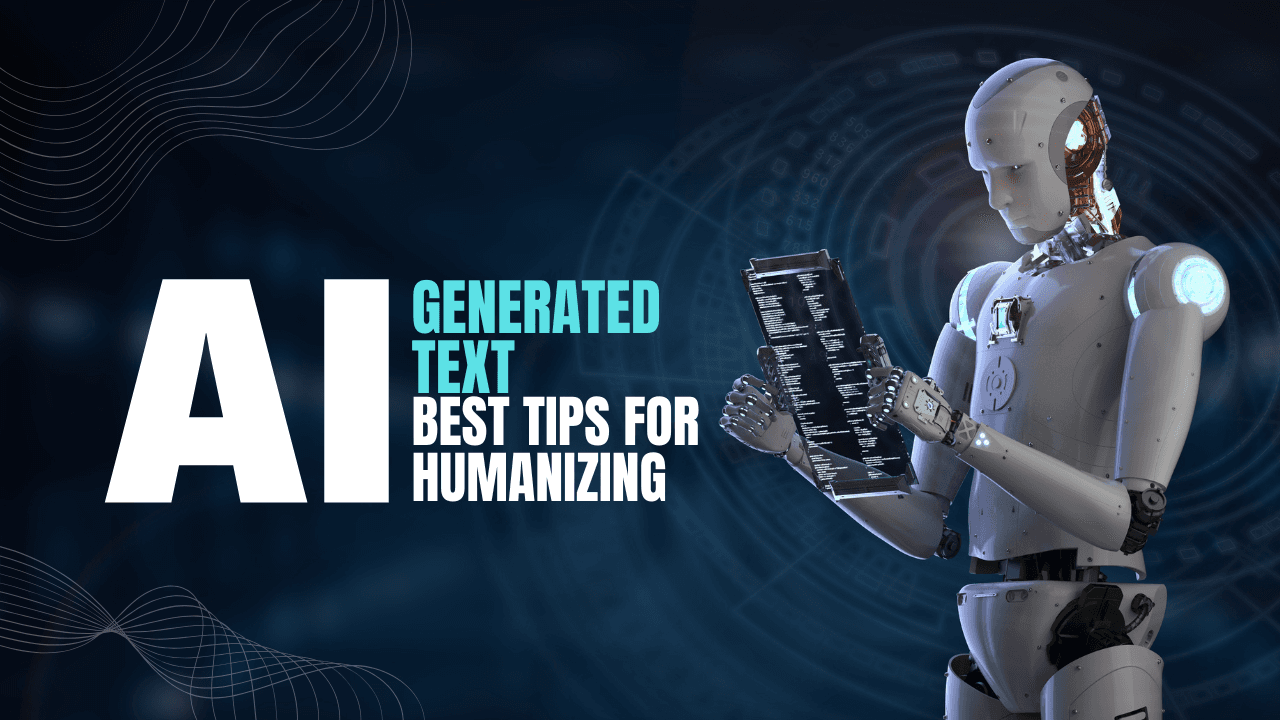AI has revolutionized the way we create content, offering tools that help us generate articles, social media posts, and even books in a fraction of the time it would take a human. But, as amazing as these AI writing tools are, they still leave much to be desired when it comes to creating truly engaging, natural-sounding text. Let’s face it—AI-generated text can sound robotic and dry, and sometimes, it can be difficult to get it to match your brand’s unique voice.
That’s where humanizing AI-generated text comes in. In this post, I’ll share the best tips for humanizing AI-generated content, making it sound more authentic and relatable. By the end of this blog, you’ll be equipped with the tools and strategies you need to fine-tune AI writing to feel more natural, engaging, and human.
Plus, we’ll take a look at tools like Humanize AI Text, which can help you streamline this process and make your content even better.
Why Humanizing AI Text Is So Important
Before we dive into the practical tips, let’s take a moment to talk about why humanizing AI text is so crucial in the first place. After all, we’re living in an era where AI can churn out content at lightning speed. So why not just use it as-is?

ai content vs human content
Well, AI-generated text might be fast, but it can also be stiff, impersonal, and at times, even incorrect. Whether you’re creating blog posts, marketing copy, or social media content, the quality of your writing reflects your brand. Poor-quality, robotic text doesn’t create emotional connections with your audience. It doesn’t invoke trust, and it doesn’t spark engagement.
The Problem with AI Text
Here’s where the trouble starts:
- Google’s Algorithm: Google has become exceptionally good at detecting AI-generated content. If your content lacks the human touch, it may get flagged, affecting your search engine rankings. Quality matters for SEO, and AI-generated text can sometimes miss the mark.
- Lack of Empathy: AI can process information, but it doesn’t understand emotions like humans do. It can’t create the same deep connections that a well-crafted human-written story can.
- Exaggerated Claims: How many times have you seen content that promises “Learn to speak Spanish in just 24 hours” or “Lose 20 pounds in a week”? AI tends to lean on these over-the-top claims, which can hurt your credibility.
- Hallucination: This is when the AI generates false information or references that don’t exist. Imagine writing a blog about statistics only for the AI to make up numbers and references. It happens, and it’s dangerous.
So, how do we fix this? Well, that’s where humanizing comes in. Here’s how you can do it effectively.
1. Treat AI Text as a First Draft
AI-generated content should always be viewed as a rough draft that needs refinement. You wouldn’t send out a first draft of an email or report to a client, would you? The same goes for AI text.
Think of AI as a writing assistant that provides a skeleton. You’re the one who adds the flesh. AI will give you the basic structure, but you have to go in and make it shine. Editing is key—fixing awkward phrasing, adding personality, and ensuring that the text aligns with your voice and message. This is a collaborative process, where AI helps you get started, and you finish the job by adding the human touch.
2. Personalize with Stories and Emotions
AI might churn out text, but it can’t create emotionally engaging stories or relatable experiences. This is where your storytelling skills come into play.
For example, instead of writing, “Our service is the best,” why not add a personal story that showcases why it matters? You could say something like:
“When I first tried the service, I was skeptical, but then something changed. I remember the day I saw the results, and it felt like I had unlocked a whole new level of energy.”
See how that feels more human? AI-generated text might say, “This is the best service,” but the human touch is about telling the story behind it. It’s about weaving in emotion, authenticity, and personal experience.
3. Watch Your Tone of Voice
Your tone of voice sets the mood for your entire piece. If you’re writing for a fun, young brand, you’ll want a casual, upbeat tone. But for a more professional or serious brand, you may want a tone that’s formal and authoritative.
AI often mixes up tones. You might start with a professional voice and then suddenly switch to something overly casual or laid-back. This inconsistency can make your content feel jarring and unprofessional.
To fix this, make sure you establish your tone at the beginning of the piece and maintain it throughout. It’s a good idea to keep a style guide for your brand’s voice so that you can easily edit AI text to stay on track.
4. Add Humor (When Appropriate)
Humor is tricky for AI to master. AI doesn’t understand humor in the same way we do. What it thinks is funny often isn’t—and what it delivers can fall flat. That being said, a little humor can go a long way in humanizing your content.
Consider adding light humor to your content to make it more relatable. For example, a product description that’s a little witty might be more engaging:
“Our blender is so powerful, you’ll wonder if it’s secretly a superhero in disguise.”
Humor can create a connection with your audience, but it’s essential to use it strategically. Humor should fit your brand’s personality, and it should never feel forced. Keep it light, natural, and relevant to the topic.
5. Edit the Sentence Structure
AI has a tendency to generate passive voice and long, winding sentences. While passive voice isn’t inherently bad, it can make your writing sound impersonal and boring. Readers are more engaged when they read active voice sentences. For example, instead of saying:
“The report was finished by our team,” try: “Our team finished the report.”
Not only is this more engaging, but it’s also more direct. It’s how people naturally speak and write.
Additionally, check for repetitive sentence structures. If the AI is repeating itself, break up those patterns and add variety. Mix up sentence lengths, from short, punchy ones to longer, more descriptive ones.
6. Format Your Articles
We often focus so much on the content itself that we forget about how it’s presented. Your content might be amazing, but if it’s buried in a wall of text, readers won’t engage with it.
Here’s what you can do:
- Use headers to break up large chunks of text.
- Add bullet points for easy-to-read lists.
- Use bold or italicized text to highlight important information.
A well-structured article is far more engaging than one that looks like an endless scroll. Think of formatting as a way to organize your thoughts and make the content more digestible.
7. Check the Facts
AI doesn’t always get the facts right. Sometimes, it will generate false information, or “hallucinate” statistics, facts, or references that don’t exist.
Before you hit publish, always check the facts in your AI-generated content. Verify statistics, sources, and URLs to ensure accuracy. Nothing kills your credibility faster than wrong information.
8. Watch for Weird Expressions
AI can sometimes create odd, clunky expressions that just don’t make sense in everyday language. One example that I’ve seen AI produce is:
“She watched me with a hawk’s eye.”
While this sounds vaguely poetic, it’s not a natural expression. The correct phrase would be “She watched me like a hawk.”
These kinds of weird, non-human-like expressions are common in AI-generated content. Always read through the text carefully to catch these and rephrase them in a way that sounds natural.
9. Use Humanizing Software
If you’re serious about making AI-generated text sound more human, there are tools designed specifically to help with this process. One such tool is Humanize AI Text, which can help refine AI-generated content in real-time.
This software doesn’t just fix grammar—it helps you adjust the tone, remove awkward phrasing, and ensure your text has a natural flow. It even helps with SEO optimization to ensure that your content is both human-friendly and search-engine-friendly.
Using software like this is a game-changer for anyone creating content regularly.
How Humanizing AI Text Saves Time and Boosts Quality
One of the biggest perks of humanizing AI text is the time it saves. Let’s be honest—content creation can be time-consuming. Editing AI-generated text manually can take hours, especially when you’re trying to make it sound human.
But with tools like Humanize AI Text, you can quickly polish your AI-generated content and get it ready for publication without spending hours fixing awkward phrasing, repetitive structures, or unnatural tone. This lets you focus on being creative and delivering value to your audience.

Turn ai draft into human
It’s like having a virtual editor who’s constantly on call, helping you fine-tune your content in real-time.
Final Thoughts
AI is an incredible tool, but it’s no replacement for the human touch. By following the tips above and using tools like Humanize AI Text, you can turn stiff, robotic AI text into engaging, human-like content that your audience will love.
Whether you’re creating blog posts, social media updates, or marketing copy, humanizing your AI content is key to ensuring it sounds authentic, relatable, and engaging. So don’t be afraid to embrace AI—just remember to give it that personal touch that makes all the difference.
Click here to try Humanize AI Text today and elevate your content to the next level!
Frequently Asked Questions About Humanizing AI Generated Text
Let’s address some common questions about humanizing AI-generated text:
1. How does the AI Humanizer work, and why do I need it?
The AI Humanizer rewrites your AI-generated content to make it sound more natural and human-like. It identifies stiff or robotic phrases and replaces them with more conversational, engaging language. This is crucial for keeping your readers hooked and improving SEO.
2. Can this tool make AI-generated text undetectable by AI detectors?
Yes! The AI Humanizer works to make your content less detectable by AI detectors like GPTZero and Originality.ai. By rewording content and adding natural variations, it helps your writing pass as human-generated.
3. Can I adjust the tone of AI text?
Absolutely! You can tailor the tone to fit your audience and style. Whether you need a formal, casual, or creative tone, the Humanizer gives you the flexibility to adapt the text to your needs.
4. Why is humanizing AI text important for SEO?
Humanizing AI content helps make it more engaging and relatable to readers, which leads to higher engagement rates and longer page views—both of which are essential for SEO. Plus, it helps ensure your content sounds authentic and doesn’t get penalized by Google’s algorithms.
5. How does humanizing AI text help with content marketing?
Humanized content is more relatable, more engaging, and more likely to spark conversations and shares. By adding emotion, personality, and storytelling to your AI-generated text, you create content that resonates with your audience and increases the chances of conversions.


